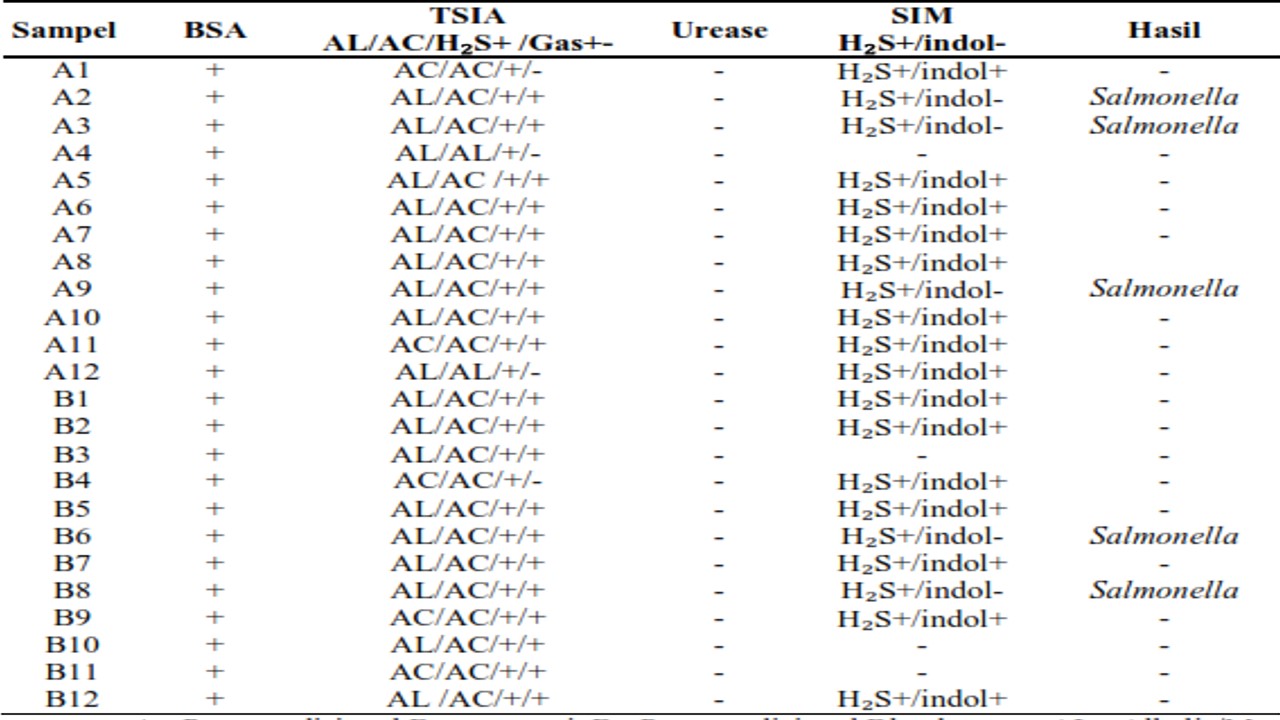Isolation and Identification of Salmonella Spp. on Broiler Meat at Banyuwangi and Blambangan Traditional Markets, Banyuwangi Regency

Downloads
Salmonella spp. is one of the major causes of the world's foodborne disease that can spread through meats, eggs, or milk. Salmonella spp. is an enteropathogenic bacteria that can cause gastrointestinal infections. This study aimed to identify the contaminations of Salmonella spp. bacteria on the broiler meats at Banyuwangi and Blambangan traditional markets Banyuwangi district. The method of this study used 24 samples of broiler meat bought from Banyuwangi and Blambangan traditional markets in the Banyuwangi District. The samples were collected using the purposive sampling method. The results found that 5 out of 24 samples (21%) were tested positive for Salmonella spp. contamination and 19 were tested negative. This study was indicated that broiler meats at Banyuwangi and Blambangan traditional markets Banyuwangi district have not suitable with SNI (Indonesia's National Standard) 3924:2009 that requires at least 25 gram of fresh chicken meat to be free of or tested negative for Salmonella.
Aerita, A. N., Eram, T. P., & Mardiana. (2014). Hubungan Higiene Pedagang dan Sanitasi dengan Kontaminasi Salmonella pada Daging Ayam Potong. Unnes Journal of Public Health, 3(4).
Afrianti, M., Dwiloka, B., & Setiani, B. E. (2013). Total bakteri, pH, dan Kadar Air Daging Ayam Broiler Setelah Direndam dengan Ekstrak Daun Senduduk (Melastoma malabathricum L.) Selama Masa Simpan. Jurnal Pangan dan Gizi, 4(1).
Afshari, A., Baratpour, A., Khanzade, S., & Jamshidi, A. (2018). Salmonella Enteritidis and Salmonella Typhimorium Identification in Poultry Carcasses. Iranian Journal of Microbiology, 10(1), 45-50.
Badan Standarisasi Nasional. (2008). SNI 2897:2008. Metode Pengujan Cemaran Mikroba dalam Daging, Telur dan Susu, serta Hasil Olahannya. Badan Standarisasi Nasional: Jakarta.
Badan Standarisasi Nasional. (2009). SNI 3924:2009. Mutu Karkas dan Daging Ayam. Badan Standarisasi Nasional: Jakarta.
Banerjee, D. K., Das, A. K., Thakur, N., Talukder, S., Das, A., Sonowal, J., Paul, B. R., Khare, R. K., & Sakunde, D. T. (2019). Factors Affecting Microbial Growth in Livestock Products: A Review. International Journal of Chemical Studies, 7(3), 4017-4022.
Deshwal, V. K. (2013). Antimicrobial Investigation of Piper nigrum L. Against Salmonella typhi. Journal of Drug Delivery and Therapeutics, 3(3), 100-103.
Estoepangestie, A. T. S., Freshca, A. A., & Boedi, S. (2014). Gambaran Resistensi Antibiotika Kuman Salmonella sp yang Diisolasi dari Daging Sapi. Jurnal Veterinaria Medika, 7(1), 67-71.
Foley, S. L., Nayak, R., Hanning, I. B., Johnson, T. J., Han, J., & Ricke, S. C. (2011). Population dynamics of Salmonella enterica serotypes in commercial egg and poultry production. Applied and Environmental Microbiology, 77(13), 4273-4279.
Jamshidi, A. E., Basami, M., & Ashari, N. S. (2009). Identification of Salmonella spp. and Salmonella typhimurium by a multiplex PCR-based assay from poultry carcasses in Mashhad-Iran. Pp: 43-48.
Kagambega, A., Alexandre T., Valentina, T., Daniel, K. S., Florent ,N. S., Evariste, B., Caroline, S. B., Aissata, W. N., Philippe, F., & Nicolas, B. (2018). Salmonella spp. and Campylobacter spp. in Poultry Feces and Carcasses in Ouagadougou, Burkina Faso. Food Science and Nutrition, 6(6), 1601-1606.
Michael, A. O., Afolabi, O. O., Friday, A. D., & Saliu, A. (2018). Evaluation of Prevalence and Antimicrobial Resistance of Salmonella spp Isolated from Chicken Eggs Sold in Ilorin, Nigeria. Archives of Current Research International, 13(2), 1-7.
Mshelbwala, F. M., Ibrahim, N. D. G., Saidu, S. N., Azeez, A. A., Akinduti, P. A., Kwanashie, C. N., Kadiri, A. K. F., Muhammed, M., Fagbamila, I. O., & Luka, P. D. (2017). Motile Salmonella serotypes Causing High Mortality in Poultry Farms in Three South-Western States of Nigeria. Veterinary Record Open, 4(1), 1-7.
Nidaullah, H., Abirami, N., Shamila-Syuhada, A. K., Chuah, L. O., Nurul, H., Tan, T. P., Abidin F. W. Z., & Rusul, G. (2017). Prevalence of Salmonella in poultry processing environments in wet markets in Penang and Perlis, Malaysia. Veterinary World, 10(3), 286.
Pimenov, N. V. (2013). Specific Control of Salmonella in Poultry. Russian Journal of Agricultural and Socio-Economic Sciences, 23(11).
Primatika, R. A., Widagdo, S. N., & Rais, D. A. (2015). Analisis Cemaran Staphylococcus aureus pada Gelas, Darah Segar, dan Jamu dengan Ramuan Darah Ular Kobra Jawa (Naja sputatrix). Jurnal Sain Veteriner, 33(2), 190-194.
Rahman, M. A., Ahmad, T., Mahmud, S., Barman, N. C., Haque, M. S., Uddin, M. E., & Ahmed, R. (2019). Isolation, Identification and Antibiotic Sensitivity Pattern of Salmonella spp. from Locally Isolated Egg Samples. American Journal of Pure Applied Biosciences, 1(1), 1-11.
Rivera-Perez, W., Barquero-Calvo, E., & Zamora-Sanabria, R. (2014). Salmonella contamination risk points in broiler carcasses during slaughter line processing. Journal of Food Protection, 77(12), 2031-2034.
Rodriguez, F. I., Procura, F., & Bueno, D. J. (2018). Comparison of 7 Culture Methods for Salmonella Serovar Enteritidis and Salmonella Serovar Typhimurium Isolation in Poultry Feces. Poultry Science, 97(11): 3826-3836.
Safitri, E., Nur A. H., & Rossy, H. (2019). Prevalensi Bakteri Salmonella pada Ayam Potong yang Dijual di Pasar Tradisional Pangkalpinang. EKOTONIA: Jurnal Penelitian Biologi, Botani, Zoologi dan Mikrobiologi, 4(1), 25-30.
Saniwanti, Nuraini, & Dian, A. (2015). Studi Residu Antibiotik Daging Broiler yang Beredar di Pasar Tradisional Kota Kendari. Jurnal Ilmu dan Teknologi Peternakan Tropis, 2(2), 30-38.
Shafini, A. B., Son, R., Mahyudin, N. A., Rukayadi, Y., & Zainazor, T. T. (2017). Prevalence of Salmonella spp. in chicken and beef from retail outlets in Malaysia. International Food Research Journal, 24(1), 437.
Copyright (c) 2022 Diana Novita Putri

This work is licensed under a Creative Commons Attribution-NonCommercial-ShareAlike 4.0 International License.
Authors who publish in this journal agree to the following terms:
1. The journal allows the author to hold the copyright of the article without restrictions;
2. The journal allows the author(s) to retain publishing rights without restrictions;
3. The legal formal aspect of journal publication accessibility refers to Creative Commons Attribution-NonCommercial-ShareAlike 4.0 International License (CC BY-NC-SA).






11.jpg)




















